







History


As the ultimate qualifier for the World Chess Championship Match, the Candidates traces its roots back to 1950. This year became the turning point in the history of chess as the first-ever Candidates Tournament, the 10-player double round-robin to determine the opponent for the world champion Botvinnik, was held in Budapest. Before this event, there was no system to decide on a world championship challenger. Any potential contender had to negotiate with the champion himself, secure funding and arrange a match.
Budapest set a long-standing tradition. Almost every third year up to 1993, the chess world celebrated the Candidates, either in the form of a tournament or of matches. The split of the world championship in the early 1990s disrupted the system; the Candidates, as part of the unified cycle, returned in 2007, first as matches. When the FIDE championship has settled into a stable format, the Candidates Tournament has come back in all its glory. The event in Madrid will be the sixth such tournament of the modern-day era, after London-2013, Khanty-Mansiysk-2014, Moscow-2016, Berlin-2018 and Yekaterinburg 2020-21.
Budapest set a long-standing tradition. Almost every third year up to 1993, the chess world celebrated the Candidates, either in the form of a tournament or of matches. The split of the world championship in the early 1990s disrupted the system; the Candidates, as part of the unified cycle, returned in 2007, first as matches. When the FIDE championship has settled into a stable format, the Candidates Tournament has come back in all its glory. The event in Madrid will be the sixth such tournament of the modern-day era, after London-2013, Khanty-Mansiysk-2014, Moscow-2016, Berlin-2018 and Yekaterinburg 2020-21.
Smyslov v Kasparov, Vilnius 1984
Photo: Boris Dolmatovsky
Photo: Boris Dolmatovsky
History of the candidates tournaments
The second Candidates became one of the most famous chess tournaments ever, thanks to the timeless popularity of excellent tournament books by participants David Bronstein and Miguel Najdorf. The tournament was a massive affair – a double round-robin with 15 contestants, meaning each participant played 28 games. The superb lineup contributed to the rich chess heritage of this event: Smyslov, Bronstein, Keres, Reshevsky, Petrosian, Geller, Najdorf, Kotov, Taimanov, Averbakh, Boleslavsky, Szabo, Gligoric, Euwe, Stahlberg (named in order of final standings). The clear winner Vasily Smyslov went on to draw his first match with Botvinnik, who therefore retained the title.

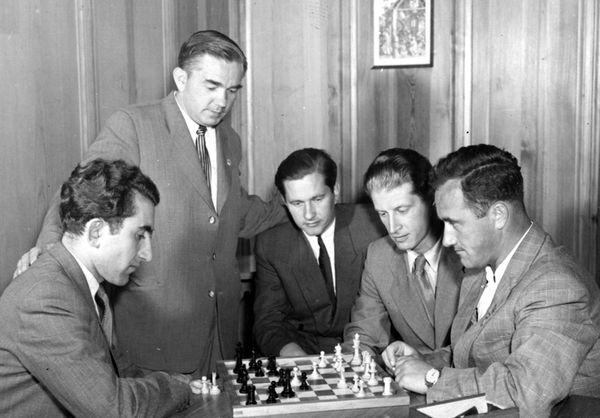
Zurich
1953
1953
Soviet participants in Zurich 1953: Tigran Petrosian, Alexander Kotov, Paul Keres, Yuri Averbakh and Efim Geller.
Photo: via @chessifyme Twitter
Photo: via @chessifyme Twitter
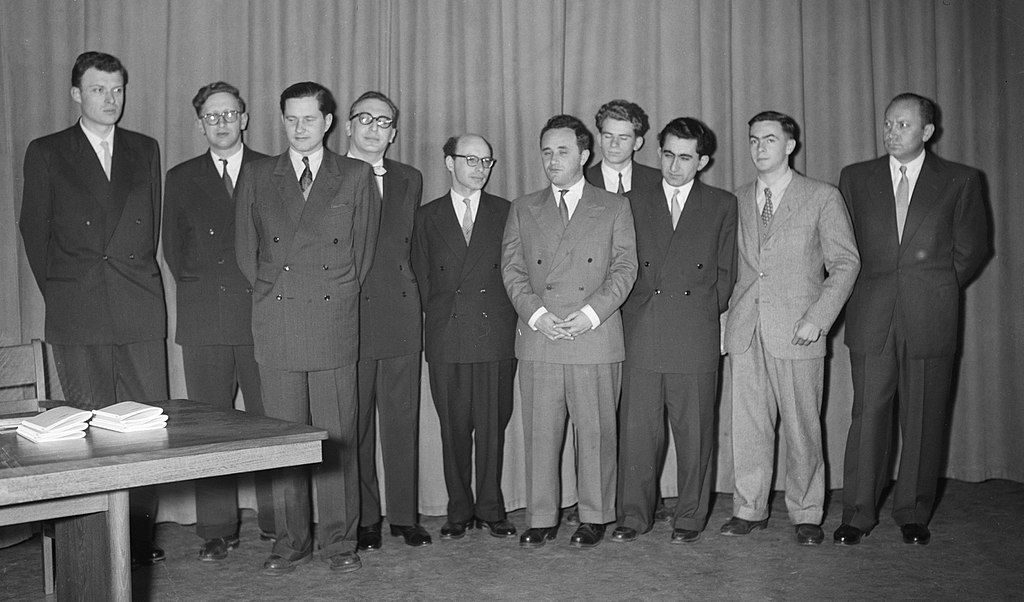
Photo: Herbert Behrens (ANEFO),
Wikimedia Commons
Wikimedia Commons
The tournament stands out for the remarkable success of Vasily Smyslov, who won the Candidates for the second time in a row. Finishing 1.5 points above the field of 10 players, he lost only one game – to 19-year-old debutant Boris Spassky. Having reached his prime form, next year Smyslov beat Botvinnik 12½-9½ in the match for the title and became the 7th World Chess Champion.

Amsterdam
1956
1956
The inaugural Candidates Tournament was held in Budapest from April 11 to May 18, 1950. It was a double round-robin with ten contenders—Bronstein, Boleslavsky, Smyslov, Keres, Najdorf, Kotov, Stahlberg, Lilienthal, Szabo, Flohr. The event in Budapest became the only Candidates Tournament to end in a tie for first place with no tiebreaker in place. Bronstein and Boleslavsky had to play a playoff match, held in the summer of 1950 in Moscow. It ended in another tie, but Bronstein won the first decisive game and became the official Challenger. He drew a match with Botvinnik, who retained his title, as an equal score favoured the champion at the time.

Budapest
1950
1950

David Bronstein and Isaac Boleslavsky, circa 1950
Photo: gpntb.ru
Photo: gpntb.ru
After winning the rematch against Smyslov 12½–10½ in 1958, Botvinnik was again the World Champion and awaited a new Challenger. The Candidates Tournament was narrowed down to 8 participants. Still, it was a quadruple round-robin, meaning each player meeting every opponent four times - 28 games in total. Three cities in Yugoslavia hosted it, with the first half played in Bled and then moving to Zagreb and Belgrade. Despite the disastrous result against Keres (1-3), the young 22-year-old debutant Mikhail Tal swept through the rest of the field – Petrosian, Smyslov, Gligoric, the other remarkable newcomer 16-year-old Fischer, Olafsson and Benko. Half a year later, “the magician from Riga” took the title from Botvinnik, defeating the Soviet chess Patriarch 12½–8½.

Yugoslavia
1959
1959
Video: Mikhail Tal joking with young Fischer by pretending to play 1…c6 before pushing the pawn further to c5.
Following the controversy surrounding the 1962 Candidates Tournament, it was decided to shift the format of the ultimate World Championship qualifier. Instead of tournaments, where Soviet players could benefit from outnumbering players from other countries, the Candidates became a series of 10-game knockout matches. A total of eight players meant the organisation of quarterfinals, semifinals and a final – a series that naturally spread throughout the year and was held in different cities. The inaugural Candidates Matches of 1965, for example, began in April and ended in November.
THE ERA OF MATCHES
The Candidates Matches of 1965 and 1968 were the golden era of Boris Spassky, who won both events. In their first match, Tigran Petrosian held his title by one point, 12½–11½, but in the second encounter, three years later, he was defeated by the younger opponent (Spassky was eight years his junior) 12½–10½.

Candidates Matches 1965 and 1968

Photo: enredaccion.com.ar
The next cycle went into the history of chess as Robert Fischer's crescendo of dominant victories, culminating in the famous 1972 Reykjavik Spassky-Fischer face-off, dubbed the Match of the Century. In the Candidates matches, Fischer beat Taimanov 6–0, Larsen 6–0, and Petrosian 6½–2½. In the World Championship Match, he decrowned Spassky 12½–8½ and became the 11th World Chess Champion.

Candidates Matches 1971
In the decade following the Match of the Century, Anatoly Karpov gathered momentum and turned into the chess scene's leading actor, winning the Candidate Matches 1977-78 and becoming the 12th World Champion following Fischer's withdrawal. His historic battles with Victor Korchnoi, winner of the 1977-78 and 1980 Candidate Matches, and later with Garry Kasparov, winner of 1983-84 Candidate Matches, are some of the 20th century chess saga's most exciting chapters.

Kasparov and Karpov in 1987.
Photo: Bart Molendijk / Anefo
Photo: Bart Molendijk / Anefo

Candidates Matches 1977-1984
The second part of the 80s was a hot time for chess: a famous unlimited match between Karpov and Kasparov in Moscow 1984-85, its interruption, the 1985 24-game replay, in which Garry Kasparov became the 13th World Champion, followed by the 1986 rematch. This series of matches has shaken the stable world championship system. As a result, the 1987 world championship match qualification was a mixture of formats and gave serious personal preferences to Karpov. Sixteen players first played a round-robin in Montpellier in 1985, from which the top four – Yusupov, Vaganian, Sokolov and Timman – qualified for the knockout phase. They played a series of matches in 1986, and the winner, Andrei Sokolov, got to play Anatoly Karpov, seeded directly into this final match. Karpov once again became the Challenger and was one game short of winning the 1987 World Championship Match in Seville. Kasparov won the 24th game on demand, levelled the score and retained the title.

Candidates Tournament and Matches 1985-1987
For the next cycle, the Candidates phase came back to matches, but this time with 14 players, whom Karpov joined in the quarterfinals. He again proceeded to win the event and played his fifth match against Kasparov in New York/Lyon in 1990, losing it 11½–12½.

Candidates Matches 1988-1989

The 1991 Candidates Matches kept the same format as three years ago – half of the 14 players were eliminated before Karpov joined in the quarterfinals. In the final, held in 1993, Short beat Timman. Amid the disagreements on the organisational side of the World Championship Match, the incumbent World Champion Garry Kasparov and the Challenger Nigel Short diverged from FIDE. They played their match under the auspices of the freshly created Professional Chess Association (PCA). In response, FIDE stripped Kasparov of his title, temporarily removed Kasparov and Short from the FIDE rating list, and held a match between Anatoly Karpov and the Candidates’ runner-up Jan Timman. Kasparov defeated Short, and Karpov beat Timman to trigger a split in the chess world that was finally resolved only 13 years later, in 2006, with the reunification match between Vladimir Kramnik and 2005 FIDE World Champion Veselin Topalov. In the years of the split, FIDE held five knockout championships. The Candidates were put on a halt.
THE SPLIT



After the reunification, the knockout FIDE World Cup and the FIDE Grand Prix Series were introduced as qualification paths for the Candidates. In 2007, the World Championship was held in the form of an 8-player double round-robin tournament in Mexico City. The Candidates Matches, which happened three months earlier, determined four out of eight participants: Aronian, Gelfand, Grischuk, and Leko. They were joined by those seeded directly into the Championship Tournament: Anand, Svidler, Morozevich (they finished 2nd–4th in San Luis 2005 where Topalov became the FIDE World Champion), and the winner of the reunification match Kramnik. "The Tiger of Madras" Anand triumphed, scoring 9 out of 14, and became the World Champion. A year later, he defended his title in the rematch against Kramnik.

Candidates Matches 2007
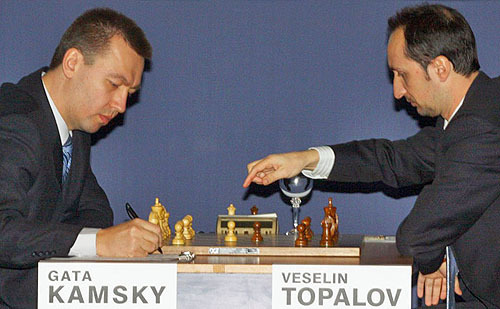
Photo via thechessdrum.net
The next cycle had only one Candidates Match between the knockout 2007 World Cup winner, Gata Kamsky, and 2005 FIDE World Champion, Veselin Topalov, who was compensated for missing the 2007 World Championship Tournament. Topalov won 4½-2½ and became the Challenger. The World Championship match between Anand and Topalov took place in Sofia, Bulgaria’s capital, in 2010. Anand won the final game to win the match by 6½–5½ and retain the title.

Candidates Match 2009
After years of disarray, the World Championship Cycle stabilised again. In 2011, the Candidates Matches were held in Kazan, Russia, with eight players taking part. Aronian and Rajdabov qualified from FIDE Grand Prix, Carlsen (replaced by Grischuk) and Kramnik by rating, Gelfand as the winner of the World Cup, Mamedyarov got the wild card. They were joined by Kamsky (runner-up of the 2009 Challengers Match) and Topalov (runner-up of the 2010 World Championship Match). 42-year-old Boris Gelfand consecutively defeated Mamedyarov 2½–1½, Kamsky in the blitz playoff, and Grischuk in the final 3½–2½ to become the Challenger for the first time in his career. The match with defending champion Anand finished at 6–6, but Gelfand lost the rapid tiebreak by 2½–1½.
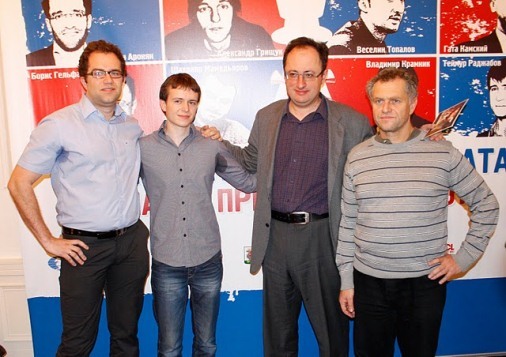
Gelfand and his team after winning the 2011 Candidates final | Photo: Moscow Chess Federation

Candidates Matches 2011
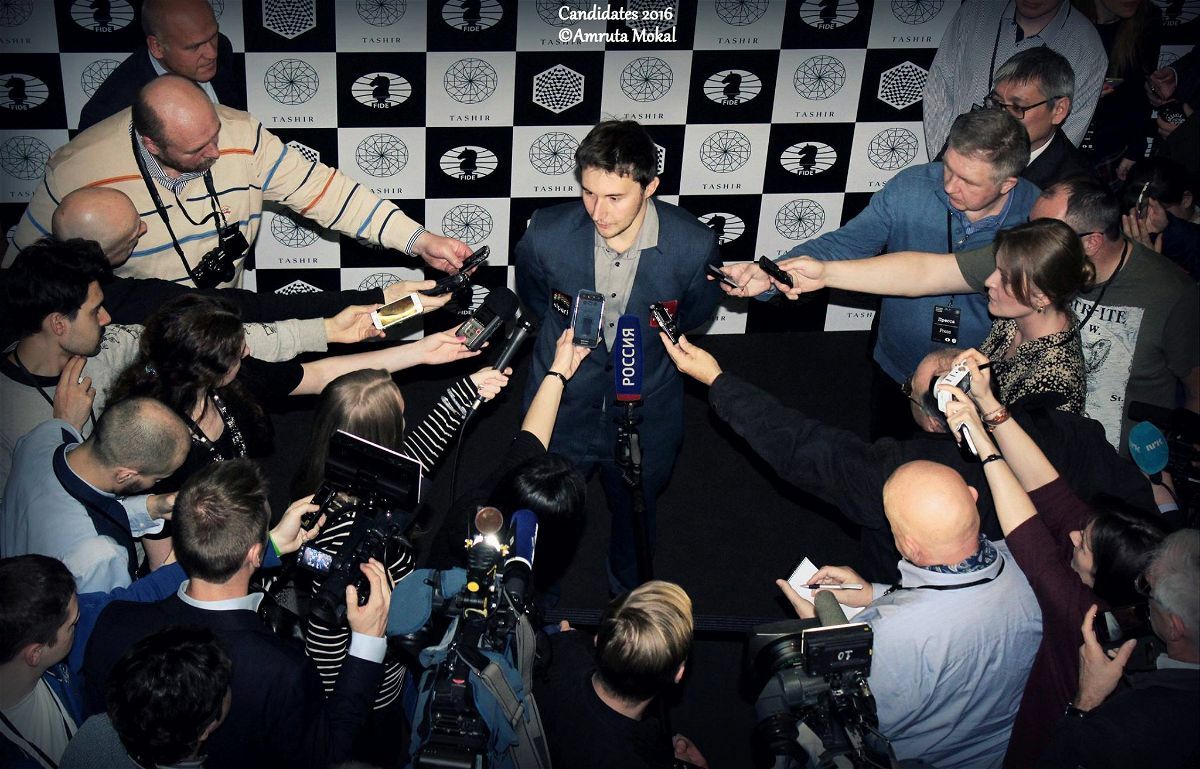
The 2016 Candidates Tournament, held in the heart of the Russian capital within walking distance from the Kremlin, brought together Topalov, Anand, Aronian, Karjakin, Svidler, Caruana, Nakamura, and Giri – for the last three, it was their debut at the Candidates. Sergey Karjakin emerged as the clear winner, losing only one game to Anand and winning four, sealing the deal with a last round victory against Caruana. Half a year later in New York, Karjakin’s team engaged in a widely advertised quest to “return the crown to Russia” but, despite Karjakin being the first to score, Carlsen bounced back, stood his ground and won the rapid tiebreak.

Moscow 2016
After the World Rapid and Blitz Championships, held in Berlin three years earlier, chess returned to the German capital with the most important tournament of the year, this time starring Karjakin, Aronian, Ding, Mamedyarov, Grischuk, Caruana, So, and Kramnik. Only Ding Liren and Wesley So did not have prior Candidates experience. For Vladimir Kramnik this was his fourth and last Candidates Tournament – a year later he announced his retirement from classical chess. One of the initial favourites, 25-year-old Fabiano Caruana, started with victories in the first and fourth rounds, nonetheless breaking away from pursuers only towards the end of the tournament and securing his success with a last-round victory. In Berlin, Caruana picked up 20 rating points and climbed to the second spot in the world – he'd hold this position from May 2018 to October 2021. The ensuing World Championship Match in London was one of the closest in history, with all twelve classical games ending in draws before Carlsen clinched the title in the rapid tiebreak.
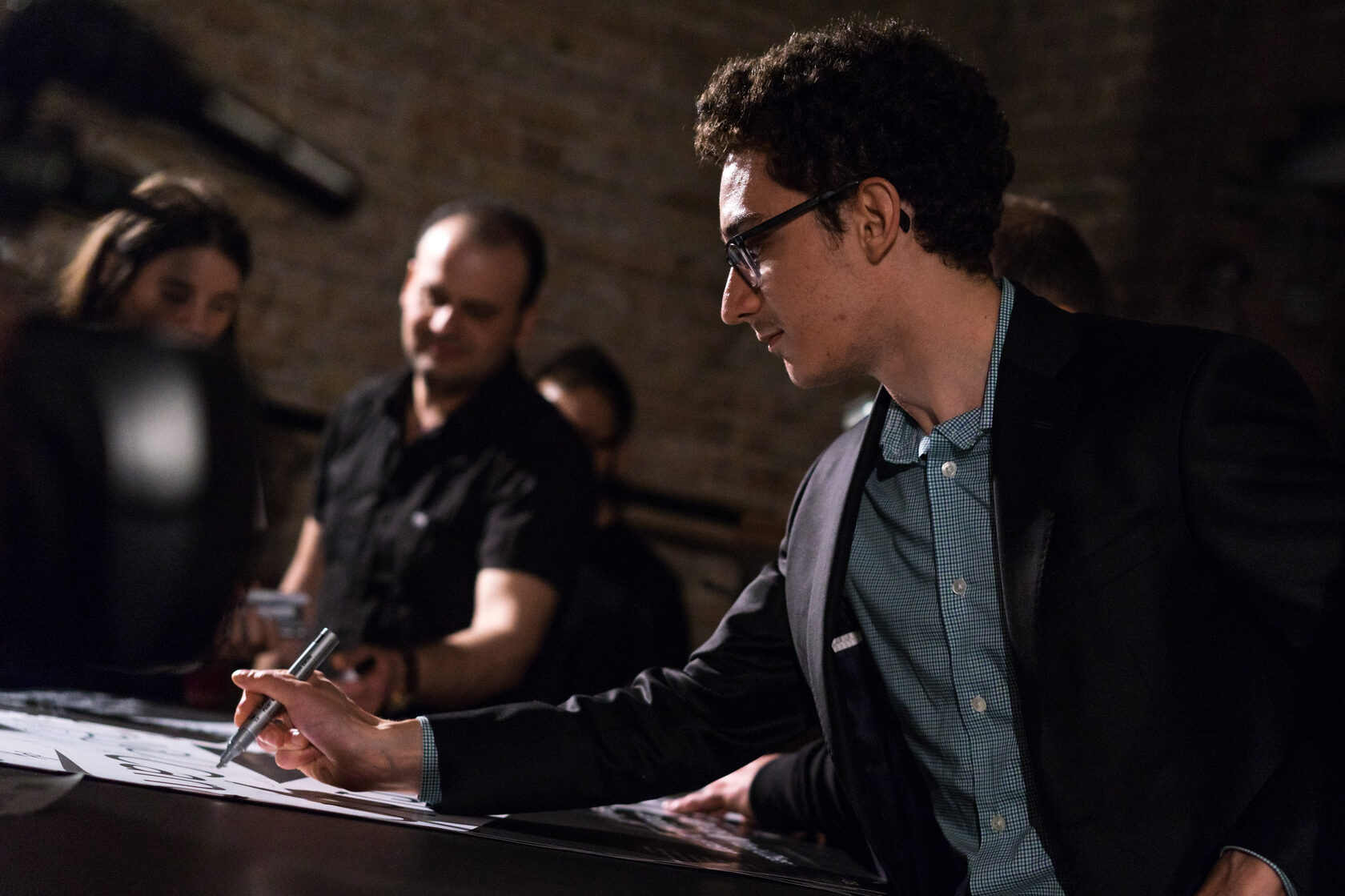
Fabiano Caruana signing tournament posters. Photo: Niki Riga

Berlin 2018
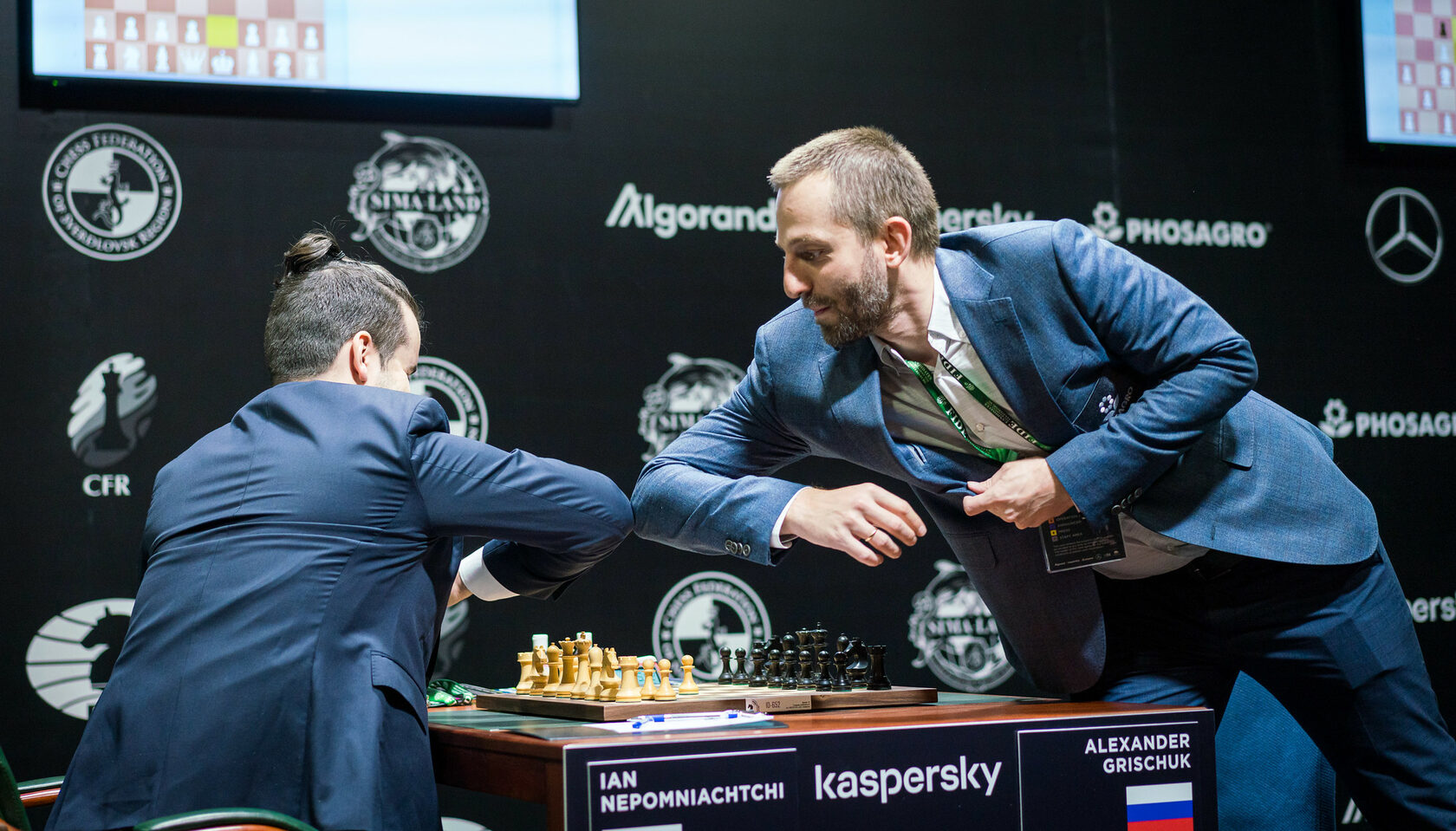
A creative replacement for a traditional handshake.
Photo: Lennart Ootes
Photo: Lennart Ootes
It took more than a year for eight grandmasters to figure out the next contender for the world title. Split in half, this tournament became the longest-running sports event in history. Apart from Caruana, Grischuk, Nepomniachtchi, Ding, Wang, Giri, Alekseenko, and Vachier-Lagrave, one more mighty player, by the name of Novel Coronavirus, pitched in. Before the start, Russia, and Yekaterinburg in particular, had registered only a handful of Covid-19 cases. Radjabov, who withdrew amid pandemic concerns, was replaced by Vachier-Lagrave, and the tournament began with a number of medical precautions in place. The players finished the first half of the tournament, Vachier-Lagrave and Nepomniachtchi finding themselves in the lead, when the Russian government announced that it was shutting down air traffic with other countries. The tournament had to be stopped and the players were urgently evacuated. FIDE made a few attempts to resume the event. In the end, it wouldn't be until 13 months later that the players returned to Yekaterinburg. In the second half, the world's #4 Ian Nepomniachtchi won two more games and claimed first place with a round to spare. Despite the promising start, he lost the World Championship Match in Dubai by 7½–3½, Carlsen defending his title for the fourth time.

Yekaterinburg 2020-21
A new chapter of the Candidates chronicle is to be written this summer in Madrid. As always, this major event promises unforgettable days of exciting chess by top grandmasters. Among the eight participants are seasoned players Radjabov, Nepomniachtchi, Caruana, Nakamura, Ding, and a bunch of newcomers – Duda, Rapport, and 18-year-old prodigy Firouzja, all at their careers’ new heights. Save the dates: June 16 – July 5, 2022.

Madrid 2022















































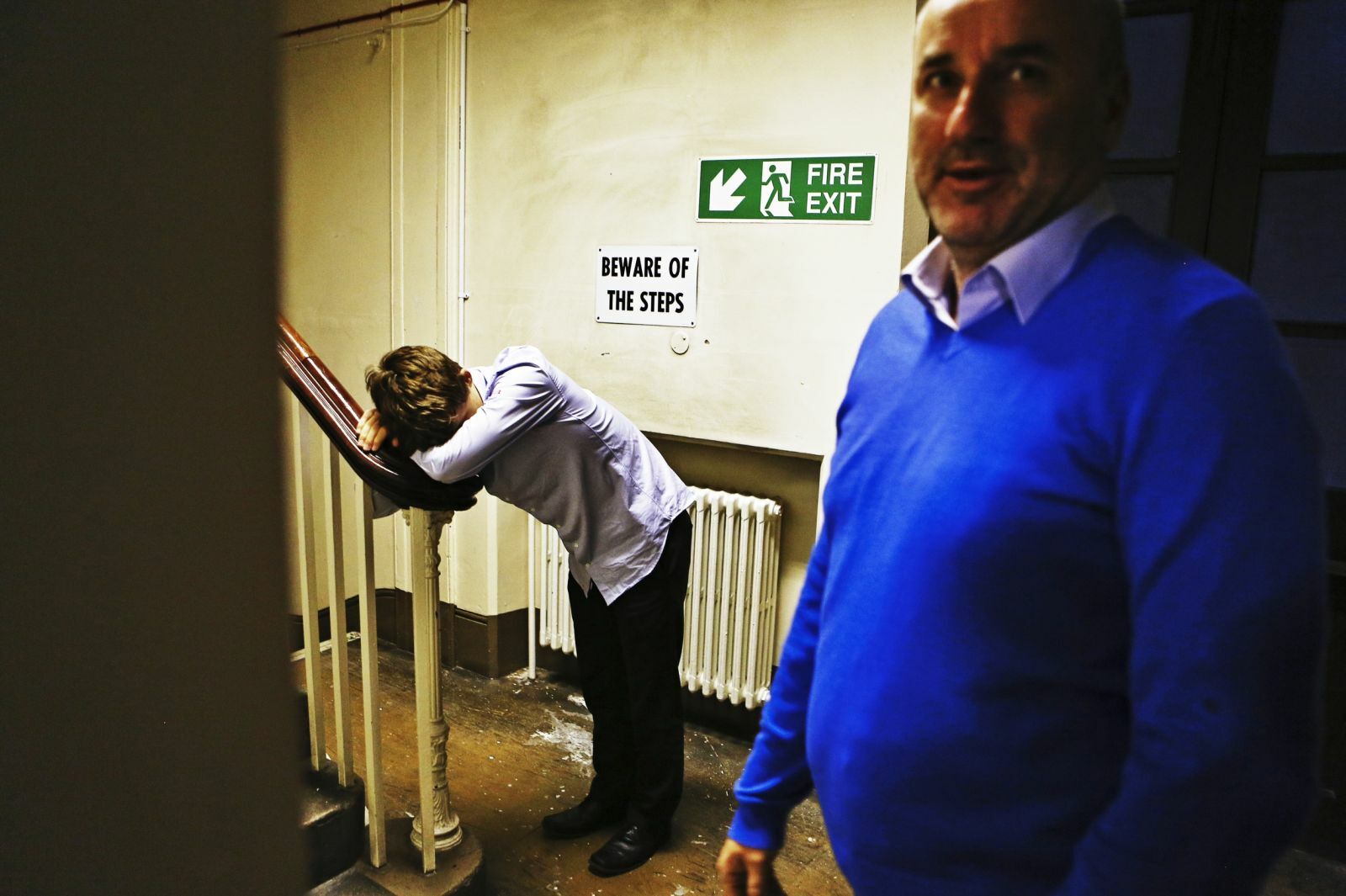
Exhausted Magnus Carlsen after losing the game but still becoming the Challenger. Photo: Morten Rakke
Fifty-one years after Curaçao, the Candidates Tournament was back. Eight players, the heirs of the legendary generations before them, gathered in London to follow in the footsteps of Spassky, Tal, and Fischer, albeit in the truncated double round-robin format – the increasingly hurrying world could hardly handle the gigantic quadruple tournaments of the past. The lineup – hardly a surprise for a tournament of such calibre – boasted of big names: Svidler, Grischuk, Ivanchuk, Gelfand, Carlsen, Aronian, Kramnik, and Radjabov. The event went down in history as one with a bizarre and dramatic finish. Both leaders, Magnus Carlsen and Vladimir Kramnik lost their last-round games, and the 22-year-old Norwegian came out on top due to the greater number of wins, the second tiebreak criterion. In November of the same year, it took Magnus Carlsen just 10 games to win the match with Viswanathan Anand in Chennai and become the World Champion.

London 2013
India's first grandmaster, the only player to win FIDE World Championship in three different formats (knockout, tournament, match), Viswanathan Anand had lost his crown just three months earlier. “Former players and media had given me poor odds at the start of the tournament,” wrote Anand in his 2019 autobiography Mind Master. “In fact, I’d predicted last place for myself and had been thinking up ways to feel less miserable. But here I was, staring at another World Championship match in seven months’ time.” The legendary champion won three games – against Aronian, Mamedyarov and, the prettiest of all, against Topalov – and drew both games versus Karjakin, Kramnik, Andreikin, Svidler to claim the victory with one round to spare, scoring 8½ out of 14 undefeated. The World Championship Match, which essentially became a rematch against Carlsen, was also held in Russia, only in its much warmer part – in Sochi. Carlsen retained the title by 6½–4½.

Viswanathan Anand enjoying the reindeer ride. Photo: Kirill Merkuryev

Khanty-Mansiysk 2014
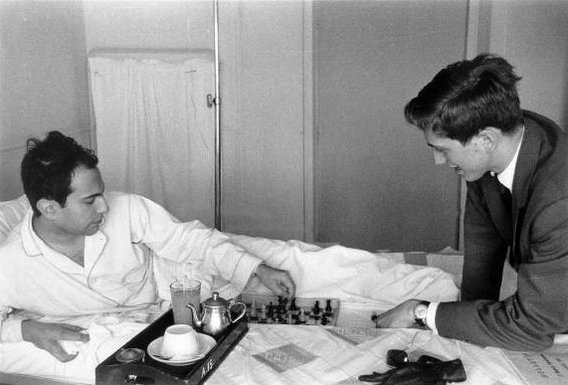
Bobby Fischer visits hospitalised Mikhail Tal
And again, the World Champion was Mikhail Botvinnik. Like Smyslov, Tal held the title only for a year before handing it back to the Patriarch, who won the rematch 13-8. The next Challenger for the resilient and ever-resourceful but ageing 50-year-old Botvinnik was to be determined in the Carribeans. The 8-player quadruple round-robin format stood another test – Petrosian, Geller, Keres, Fischer, Korchnoi, Benko, Tal and Filip were to stay on the tropical island for two months. Tal's deteriorating health did not let him finish the event, and he withdrew after 21 rounds. At the height of the Cold War, all eyes were on the performance of 19-year-old Fischer, but he was not yet ready to stand up against the Soviet chess machine, especially when its players had the benefit of making short draws between each other. Tigran Petrosian won the tournament without losing a single game and went on to become the 9th World Champion.

Curaçao
1962
1962


THE REUNIFICATION
THE START OF A TRADITION
THE TOURNAMENT RETURNS
